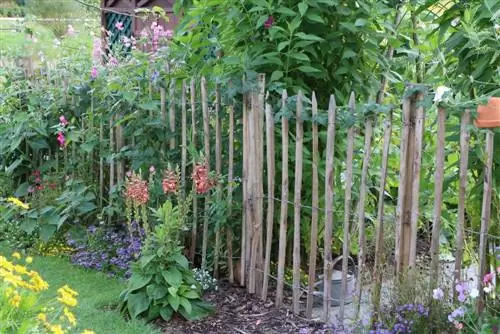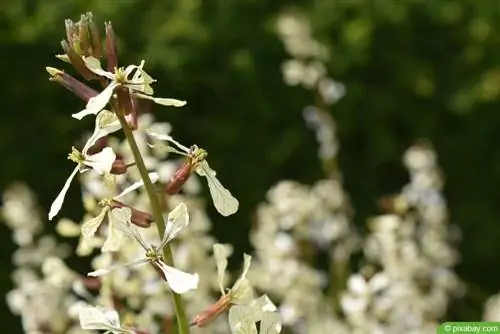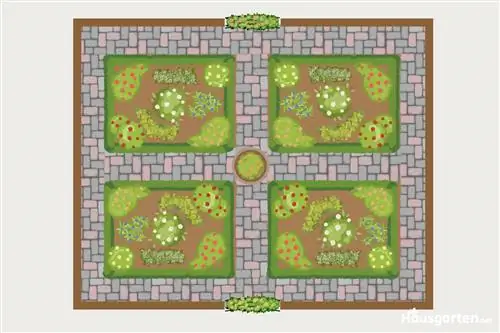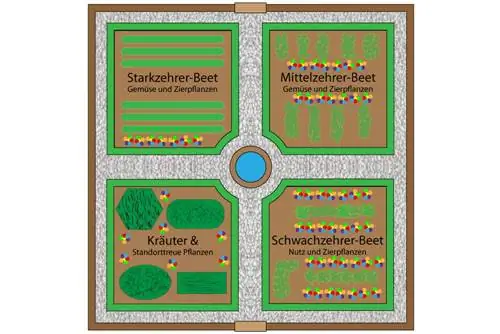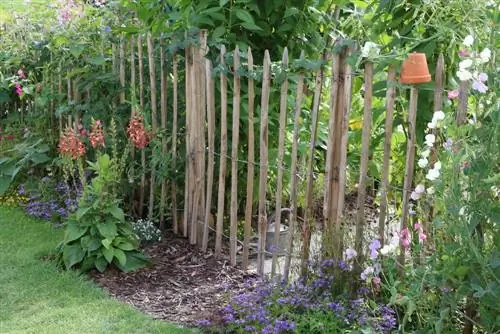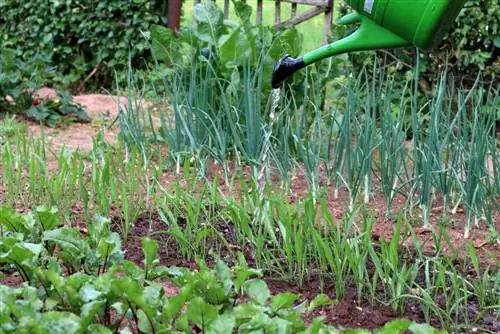- Author admin [email protected].
- Public 2023-12-17 03:39.
- Last modified 2025-06-01 06:48.
The cottage garden is considered the epitome of rural life. Here, he althy vegetables, sweet fruits, aromatic herbs and colorful flowers thrive side by side. This gem of living cultural history is cultivated in harmony with nature, without insecticides, pesticides and artificial fertilizers. To date, the classic cottage garden has undergone numerous modifications to become a flourishing kitchen garden, without losing sight of the old values. The original floor plan has been preserved and is now designed with a decorative look in mind. This guide reveals which plants will transform your cottage garden into a blooming paradise in style.
Historical floor plan is valid then as now
The cottage garden gets its special character from a traditional floor plan that has survived the changing times unchanged. The concept was born from the medieval monastery gardens with four separate gardens: garden of the large cloister, orchard, vegetable garden and herb garden. The farmers at the time had little land of their own, so out of necessity they combined all four gardens into one unit. To plan your private cottage garden, please first create a sketch of the floor plan with these components:
- A crossroads with 4 beds of the same size
- A roundel at the intersection as an eye-catcher
- A fence as an enclosure with 1 to 2 entrances
- A circular path between the fence and flower beds as a way to work
- Bedgings frame each bed
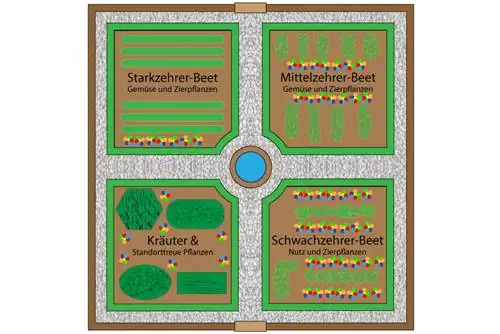
You can enhance this simple floor plan by incorporating various decorative elements into the design. These include a bench, a rose arch over the entrance, stone statues, a covered fountain or a green trellis. Natural materials such as wood and stone dominate the cottage garden. Therefore, bark mulch, decorative gravel, chippings, natural stone or lawn are the main choices for path surfaces. A stylish, historically correct fence can be a picket fence, a hunter's fence or a woven willow fence. Where space allows, a planted dry stone wall surrounds the site and gives your cottage garden an authentic touch.
Fence catchers for a blooming enclosure
The fence in your cottage garden is transformed into a flowering bulwark with fence-peeper plants. Tall perennials that require support find ideal conditions here to compete with the blooms of the beds. Browse the following selection:
- Hollyhock (Alcea) 'Parkallee' transforms every fence into a summery flower fairytale in light yellow
- Hemp-leaved marshmallow (Althaea cannabina) delights with a flowering period from July to October
- Rough-leaf asters (Aster novae-angliae) bathe the autumnal cottage garden in a salmon-pink sea of flowers
- Clematis will remain loyal to you for many years with their opulent abundance of flowers
- Sun Bride hybrid 'Baudirektion Linne' (Helenium) adorns the fence and provides long-blooming cut flowers
Two classics for greening a cottage garden fence should not be missing here. The perennial sunflower (Helianthus decapetalus 'Triomphe de Gand') grows to a height of 150 to 180 cm and shines with bright yellow flower discs that compete with the sun. Dahlias (Dahlia) are in no way inferior to this flower spectacle on the garden border. Beauties such as the peony-flowered dahlia or the ball dahlia stretch up to 150 cm towards the sky and welcome visitors to your cottage garden.
Tip:
A cottage garden can only develop its romantic plant splendor if you choose a sunny to semi-shady location. The soil should be rich in nutrients, fresh to moderately dry and loose and permeable.
Plants for borders
Buxus dominated as a bed border in formal cottage gardens for centuries. The explosive spread of the boxwood borer, accompanied by shoot death, put an end to this tradition. Today, small evergreen trees or flowering plants adorn the frame of the four beds. The following selection introduces you to suitable species and varieties as a boxwood replacement:
- Mountain Ilex (Ilex crenata), whose variety 'Dark Green' looks very similar to Buxus
- Dwarf privet (Ligustrum vulgare), the variety 'Lodense' grows compact, dense and evergreen
- Small-leaved rhododendron (mictranthum), here the variety 'Bloombux' with robust cutting tolerance
- Purple chives (Allium schoenoprasum), an eye-catcher not only in the herb bed thanks to their pretty flowers
- Lavender (Lavender officinalis) the ideal border for sunny locations
- Carnation (Armeria maritima), especially the variety 'Düsseldorfer Stolz' with bright red flower heads
The horizontal autumn aster (Aster lateriflorus var. horizontalis) provides an autumnal flower display around your cottage garden beds. The dark-leaved variety 'Prince' gives the border the look of a small, flowering avenue. We don't want to withhold the dwarf straw flower (Helichrysum italicum) from you here as a fragrant bed border. The needle-like, shimmering silver foliage harmonizes wonderfully with the yellow flowers and provides the kitchen with fresh herb shoots with a spicy curry flavor.
Vegetable plants from classic to modern
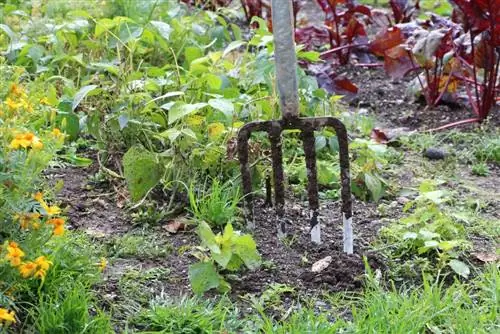
The basic structure of a cottage garden with 4 beds around a crossroads is based on the traditional 4-field economy in mixed culture. This system of land exchange has been known since the 11th century and is still recognized today. Low, medium and heavy feeders are planted in separate beds, which are changed annually so that the soil does not become depleted. The fourth bed is used to cultivate plants, herbs or berry bushes that are consistent with the location. If you intend to follow this principle, the following list offers you an overview of popular vegetable plants, classified according to their nutrient requirements:
Weak eater
The following crops are content with a low supply of nutrients. If heavy and medium feeders have colonized a bed, either leave the area fallow for a year or plant it with these hunger artists:
- Faba bean (Vicia faba), whose pretty flowers also serve as a meadow for bumblebees and butterflies
- Peas (Pisum sativum), which only receive a little compost to produce a bountiful harvest
- Lamb lettuce (Valerianella locusta) gives you magnificent heads of lettuce even without fertilizer
- Radish (Raphanus sativus var. sativus) gives you spicy, hot tubers until autumn
Among the historical vegetables, lentils (Lens culinaris) score points with an uncomplicated care program that is limited to watering and weeding. Avoiding fertilizer does not detract from a rich harvest. In the large farm garden, the green columns of mighty runner beans (Phaseolus vulgaris) announce from a distance that work is being carried out here according to the ancient customs. A little compost is enough to enjoy freshly harvested, vitamin-rich vegetables after a ripening period of 8 weeks.
Middle eaters
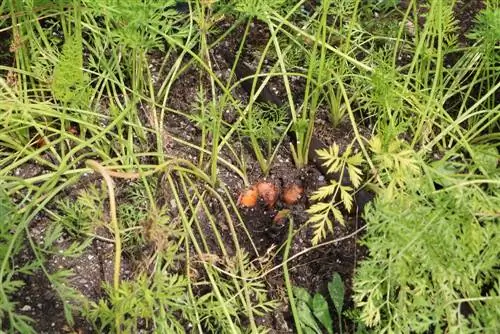
The following types of vegetables follow the heavily consuming plants in the bed. By taking this crop rotation to heart, you will outwit pests and pathogens that are now waiting in vain for another season with heavily consuming plants:
- Common chicory, chicory (Cichorium intybus) gives us light blue ray flowers and tasty vegetables
- Chard (Beta vulgaris subsp. vulgaris var. vulgaris) loosens the soil deeply with its taproots
- Carrots (Daucus carota) the popular, fruity vegetable that even children enjoy eating
- Parsnip (Pastinaca sativa), known as Germanic root and has always been an integral part of farm gardens
- Leek (Allium ampeloprasum), the 'prince of winter' loves comfrey manure as a natural fertilizer
A vegetable that enriches the menu in both summer and winter has now lost all fear for your children. Spinach (Spinacia oleracea) delights as a summer spinach with a delicate aroma and comes to the table as a winter spinach with a hearty taste.
Heavy eaters
The following vegetable plants have a high need for nitrogen and other nutrients. It therefore makes sense to plant them in a different bed every year:
- Cauliflower (Brassica oleracea var. botrytis L.) requires plenty of manure to satisfy its great hunger
- Kale (Brassica oleraceae) tastes best as an autumn vegetable after a night of frosty temperatures
- Potatoes (Solanum tuberosum), bring a rich harvest after plenty of compost and professional piling
- Brussels sprouts (Brassica oleraceae var. gemmifera) reward intensive care with delicious, firm sprouts
- Red cabbage (Brassica oleracea convar. capitata var. rubra), like all types of cabbage, depends on a regular supply of nutrients
Since tomatoes (Solanum lycopersicum) found their way into European cottage gardens, they have enjoyed unbroken popularity. As heavy feeders, the red paradise apples require regular attention, which is not limited to organic fertilization every 2 weeks. Only in combination with consistent mulching, watering and thinning will you pave the way to plump, juicy tomatoes with a unique taste.
Tip:
The planting plan in the cottage garden must not ignore the fact that not all useful and ornamental plants get along in mixed culture. For example, a close proximity of peas and potatoes should be avoided. Cucumbers and potatoes hinder each other, as do cabbage and kohlrabi, leeks and beans or celery and lettuce.
Powerful symbolism with Marian flowers
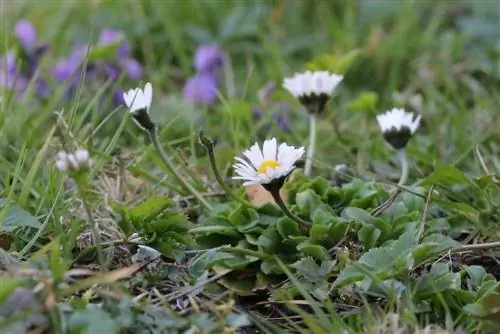
You will give your cottage garden a special authenticity if you integrate Marian flowers into the planting plan. As early as the Middle Ages, peasant women planted flowers to use them to decorate altars in honor of the Mother of God. Traditionally, colorful bouquets of flowers and herbs are consecrated during church services on Assumption Day. The following plants still signal their sacred symbolic power with their common names:
- Daisies, St. Mary's flowers (Bellis perennis) with a flowering period from March to November
- Milk thistle, savior thistle (Silybum marianum) with purple basket flowers and effective healing powers
- Ladygrass (Hierochloe odorata), the fragrant ornamental grass for all nutrient-rich soils
- Madonna lily (Lilium candidum), the majestic onion flower with pure white flowers
The columbine (Aquilegia vulgaris) symbolizes the seven sorrows of Mary and, thanks to its robust winter hardiness, is ideal for naturalizing as an underplant for fruit trees. In this context, the wild strawberry (Fragaria vesca) functions as an allegory of virgin motherhood.
Romantic cottage garden perennials
It is the following cottage garden perennials that shape the romantic character of the nostalgic garden concept. These are located in the middle of crops. Please allow yourself to be guided by a balanced coordination of the different growth heights. It is the job of the perennials to create decorative accents without overgrowing the vegetable plants and cutting them off from light. If you combine species with different flowering times, the festival of colors continues seamlessly throughout the entire growing season.
- Lily of the valley (Convallaria majalis), height 20-25 cm, flowering time in May and June
- Knapweed (Centaurea montana), height 40-50 cm, flowering period from May to July
- Autumn anemone 'Queen Charlotte' (Anemone Japonica), height 60 cm, flowering period from August to October
- Double Betramsgarbe 'Snowball' (Achillea ptarmica), height 70 cm, flowering period from May to winter
- Perennial peonies (Päonia), height 50-80 cm, flowering time in May and June
- Imperial crown (Fritillaria imperialis), height 120 cm, flowering time in April and May
The dark bearded carnation (Dianthus barbatus 'Nigrescens') is breathtakingly beautiful and perfect for the flowering kitchen garden. With a height of 35 cm, it goes well with many vegetable plants and creates a floral flair all summer long. Wherever the two-year-old flower feels comfortable, it will reseed itself every year. Without the sun bride (Helenium), your cottage garden would be missing a classic element. The majestic perennial grows to a height of 120 to 140 cm and boasts yellow-red flower discs from August to October.
Annual flowers create floral variety
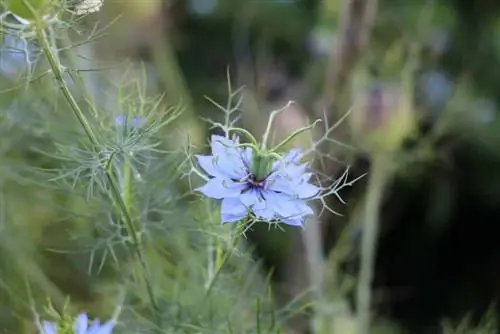
So that your flowering kitchen garden doesn't freeze in a firmly cemented pattern with perennials, the following annual summer flowers provide colorful entertainment. The following selection focuses on proven classics that have proven themselves ideal for designing a cottage garden:
- Virgin in the countryside (Nigella damascena), height 45 cm, flowering period from June to August
- Cup mallow (Lafathera), growth height 80-100 cm and beyond, flowering period from June to September
- Marigold (Calendula officinalis), height 30-50 cm, flowering period from June to October
- Levkoje (Matthiola), height 10-80 cm, flowering period from April to October
- Lupins (Lupinus), height 40-80 cm, flowering period from May to August
Obligatory for your cottage garden are gladiolus (Gladiolus), which rise from their tubers up to 100 cm with their flower candles from June onwards. Dig up before the first frost and overwintered dry, the majestic flowers repeat their blossom festival next year. Only when the red, delicate flowers of corn poppies (Papaver rhoeas) dance through the garden is the summer play of colors perfect. Thanks to a growth height of 20 to 90 cm, the natural flower finds a place in every bed.
Berry bushes for snacking and preserving
If you take a look at traditional floor plans, berry bushes are usually located along the fence. If you follow this tradition, simply add a gap of 60 to 100 cm wide between the fence and the surrounding work path in your sketch. There is enough space for the following berry bushes to pamper the whole family with fruity vitamin bombs:
- Blackberry (Rubus fruticosus) with pink-white flowers from May to August and black berries in autumn
- Blueberry (Vaccinium myrtillus) with red flowers from April to May and blue-grey frosted berries in late summer
- Raspberry (Rubus idaeus) with white panicle flowers from May to August and red, yellow or black berries
- Gooseberry (Ribes uva-crispa) with red-green flowers in May and large, green fruits in summer
Where space allows, the tried and tested elderberry (Sambucus nigra) comes into its own. The majestic berry bush is still one of the most common shrubs in Central Europe. Our ancestors already knew how to use it as a natural food, medicinal and dye plant. In a small cottage garden, you don't have to do without the long-serving tree, because the 'Black Tower' variety takes up significantly less space as a columnar elderberry.
Herbal and medicinal plants - beautiful and useful
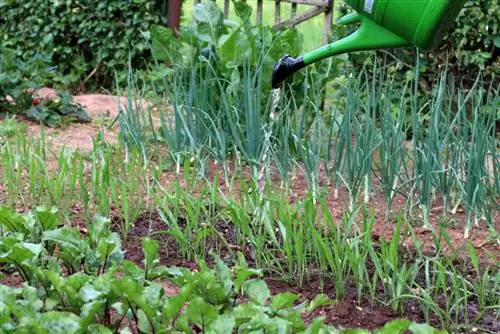
The spectrum of herbs and medicinal plants for the authentic cottage garden and flowering kitchen garden is broad. Personal preferences and usage should be the main consideration when making your selection. For your inspiration, we have put together the following overview of common species and varieties for you; supplemented with information on height and flowering time to take the decorative aspect into account:
- Meadow sage (Salvia pratensis), height 60 cm, flowering period May to August with blue flower candles
- Purple angelica (Angelica sylvestris), height 80 cm, flowering period from July to September in white, pink or red
- German tarragon (Artemisia dracunculus var. sativus), height 50-70 cm, flowering time in May and June
- Blue hyssop (Hyssopus officinalis), height 40-60 cm, bright blue flowers from July to August
- lovage, maggi herb (Levisticum officinale), height 100 cm, with red shoots and yellow flowers from June
The native Bärwurz (Meum athamanticum) deserves a regular place. After being forgotten for some time, the cottage garden classic is now experiencing a furious revival. With a growth height of 20-40 cm and white flowers from May to June, it also likes to showcase itself in rustic planters. You won't want to miss curly parsley (Petroselinum crispum) in the herb bed either. With its white flowers and curled leaves, the popular culinary herb has no objection to a light and shady place.
Conclusion
In order to design a cottage garden as a romantic oasis of well-being in harmony with its history, precise planning and creative ideas are required. The classic floor plan with nostalgic fencing, crossroads, 4 beds and a surrounding path serves as a guide. On this basis, you can draw up a planting plan that offers plenty of space for implementing imaginative planting. This guide with multi-faceted ideas aims to help make your dream of a blooming kitchen garden come true in the best possible way.

